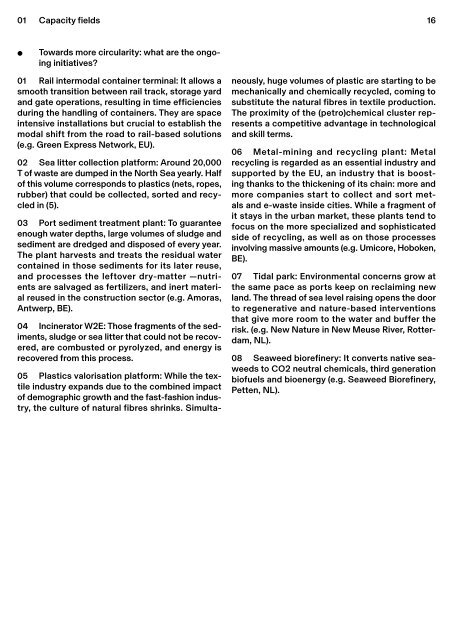Circular (City) Ports_Workbook 2_ Buildings Blocks
You also want an ePaper? Increase the reach of your titles
YUMPU automatically turns print PDFs into web optimized ePapers that Google loves.
01 Capacity fields<br />
16<br />
●<br />
Towards more circularity: what are the ongoing<br />
initiatives?<br />
01 Rail intermodal container terminal: It allows a<br />
smooth transition between rail track, storage yard<br />
and gate operations, resulting in time efficiencies<br />
during the handling of containers. They are space<br />
intensive installations but crucial to establish the<br />
modal shift from the road to rail-based solutions<br />
(e.g. Green Express Network, EU).<br />
02 Sea litter collection platform: Around 20,000<br />
T of waste are dumped in the North Sea yearly. Half<br />
of this volume corresponds to plastics (nets, ropes,<br />
rubber) that could be collected, sorted and recycled<br />
in (5).<br />
03 Port sediment treatment plant: To guarantee<br />
enough water depths, large volumes of sludge and<br />
sediment are dredged and disposed of every year.<br />
The plant harvests and treats the residual water<br />
contained in those sediments for its later reuse,<br />
and processes the leftover dry-matter —nutrients<br />
are salvaged as fertilizers, and inert material<br />
reused in the construction sector (e.g. Amoras,<br />
Antwerp, BE).<br />
04 Incinerator W2E: Those fragments of the sediments,<br />
sludge or sea litter that could not be recovered,<br />
are combusted or pyrolyzed, and energy is<br />
recovered from this process.<br />
05 Plastics valorisation platform: While the textile<br />
industry expands due to the combined impact<br />
of demographic growth and the fast-fashion industry,<br />
the culture of natural fibres shrinks. Simultaneously,<br />
huge volumes of plastic are starting to be<br />
mechanically and chemically recycled, coming to<br />
substitute the natural fibres in textile production.<br />
The proximity of the (petro)chemical cluster represents<br />
a competitive advantage in technological<br />
and skill terms.<br />
06 Metal-mining and recycling plant: Metal<br />
recycling is regarded as an essential industry and<br />
supported by the EU, an industry that is boosting<br />
thanks to the thickening of its chain: more and<br />
more companies start to collect and sort metals<br />
and e-waste inside cities. While a fragment of<br />
it stays in the urban market, these plants tend to<br />
focus on the more specialized and sophisticated<br />
side of recycling, as well as on those processes<br />
involving massive amounts (e.g. Umicore, Hoboken,<br />
BE).<br />
07 Tidal park: Environmental concerns grow at<br />
the same pace as ports keep on reclaiming new<br />
land. The thread of sea level raising opens the door<br />
to regenerative and nature-based interventions<br />
that give more room to the water and buffer the<br />
risk. (e.g. New Nature in New Meuse River, Rotterdam,<br />
NL).<br />
08 Seaweed biorefinery: It converts native seaweeds<br />
to CO2 neutral chemicals, third generation<br />
biofuels and bioenergy (e.g. Seaweed Biorefinery,<br />
Petten, NL).


















